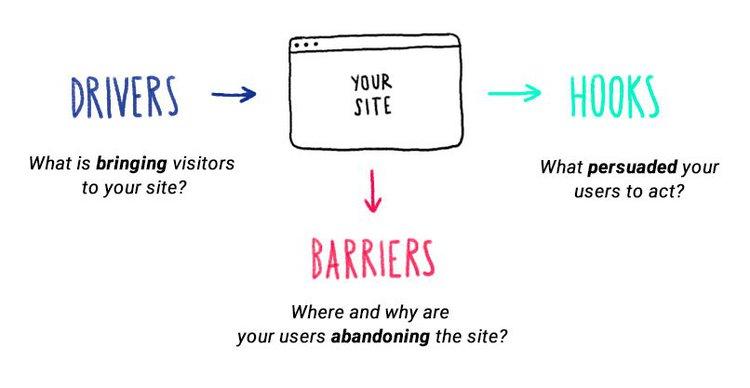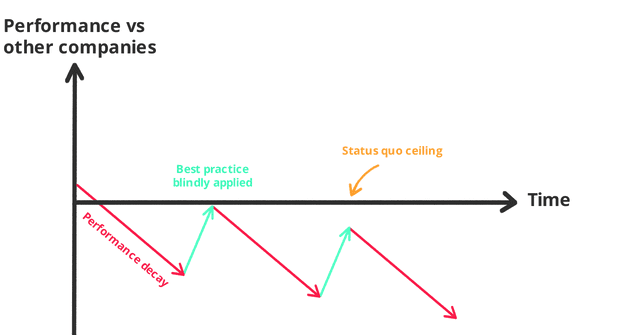Conversion rate optimisation (CRO) is the practice of increasing the percentage of users who perform a desired action on a website. Desired actions can include purchasing a product, clicking ‘add to cart’, signing up for a service, filling out a form, or clicking on a link.
A more user-centric definition of CRO
Standard definitions of CRO, like the one we just wrote above, place their focus on conversion percentages, averages, and benchmarks. This emphasis on a numerical approach comes with a downside—the more you look at spreadsheets full of conversion data points and actions, the less you think of the individuals behind them.
Here is an alternative, more holistic and user-centric way of defining CRO: think of it as the process of focusing on understanding what drives, stops, and persuades your users, so you can give them the best user experience possible—and that, in turn, is what makes them convert and ultimately improves your website conversion rate.
Why do we think this second definition works better? Because focusing on the final action—the conversion—is important, but in reality, a lot happens before that point:
- Specific DRIVERS bring people to your website
- Specific BARRIERS make them leave
- Specific HOOKS persuade them to convert

When this happens, you’ll need to dig deeper to understand the why beyond the data you have—you’ll need, in other words, to focus on your users first. And that’s what we think CRO is actually about.
Whether you own an ecommerce site or manage online marketing or SEO (search engine optimisation), CRO will constantly be a top-of-mind topic to help your organization grow.
How to calculate conversion rate.
The conversion rate is calculated by dividing the number of conversions (desired actions taken) by the total number of visitors and multiplying the result by 100 to get a percentage.

For example, if your web page had 18 sales and 450 visitors last month, your conversion rate is 18 divided by 450 (0.04), multiplied by 100 = 4%.
What is the average conversion rate?
Depending on what you read, the average conversion rate is anywhere between 1% and 4%.
But let us come out and say it: this figure is sort of meaningless, since:
- Conversion rates differ wildly depending on the conversion goal (ad clicks, checkout completions, newsletter signups, etc.)
- Every website, page, and audience is different
- Most people don’t share their conversion data publicly anyway
Averages may be useful as starting points for benchmarking, but what do they have to do with YOUR website?
There is no actual, ultimate industry figure you can rely on or compare yourself against with 100% confidence. Obsessing over an average percentage figure, and trying to squeeze as many conversions as possible just to stay in line with it, is not the best way to think about conversion rate optimisation.
Once again, you’re better off focusing on developing an in-depth understanding of what matters to your users, so you can give it to them—and then, conversions will naturally follow.
CRO best practices – why they’re dangerous
In the world of digital marketing, a CRO best practice is a commonly-held belief that a particular optimization action will guarantee an increase in conversion rate, for example:
- Use a strong colour for all CTA (call-to-action) buttons
- Place CTAs above the fold
- Use urgency (e.g., time-limited offers) to drive sales
- Always display testimonials
- Use fewer form fields on your forms
Are these best practices good for improving YOUR conversion rate? Debatable.
First of all, best practice is—by definition—past practice: it’s something that worked in the past for someone else. You can’t guarantee it’s going to work today.
Second, just because it worked for someone else, doesn’t mean it’s going to work for you.
Blindly applying existing best practices puts companies in a perpetual state of playing catch-up—while more progressive and experimental businesses are busy improving and making the changes that will be recognised as ‘best practices’ in a few years.

There is, however, one core principle we can recommend as always valid: spend time understanding your users and customers—or build a customer-centric culture by obsessing over your users and customers.
They are the people who matter to your business and have the answers you need to improve it. Fixate on their needs and desired outcomes, learn as much as you can about their concerns and hesitations, and then deliver solutions that address them.
In the long term, what leads to growth is not blindly applying best practices that you see on other blogs or hear from your boss(es). The winning approach is investing in understanding and learning from your users and using the insight to build an optimization strategy that continuously improves your business.
How do I improve my conversion rate?
To improve your conversion rate, use CRO tools to analyze web pages that are underperforming according to your conversion goals, and find out what could be preventing visitors from taking a desired action—for example, clicking a CTA button, joining an email list, or adding something to their shopping cart.
Once you’ve identified any blockers your website visitors are experiencing, you can make more informed decisions about what changes should be tested on your pages (with predictive personalisation, A/B testing or multivariate testing) to improve conversion rates.
Note: you should also analyze your highest-converting pages to see what does work—what is it that convinces customers to make it through the conversion funnel on those pages?





